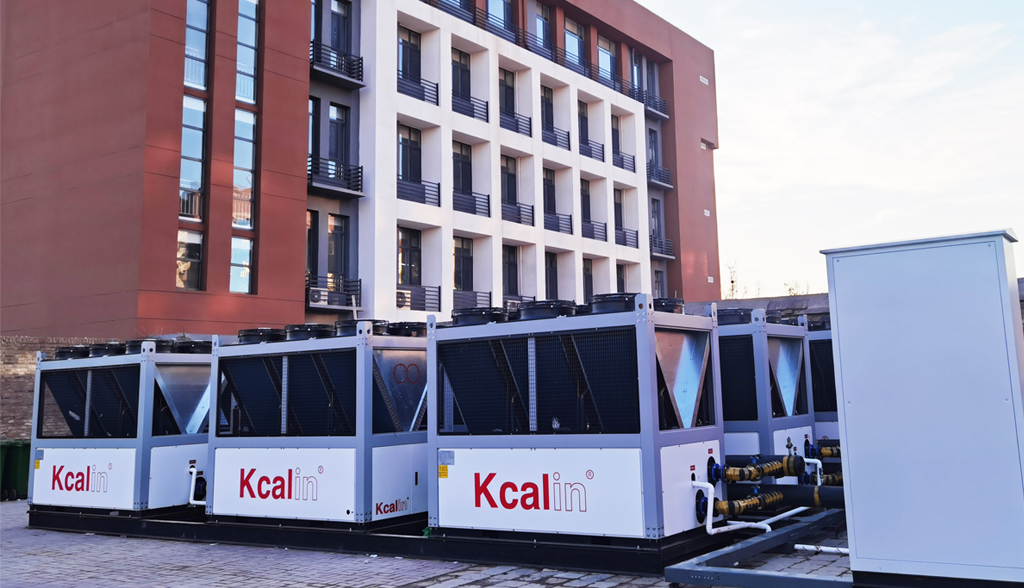The intensification of climate change and energy crisis has led to an increasing demand for energy conservation and environmental protection in school heating and cooling systems. Traditional heating and cooling systems have high energy consumption and low efficiency, making it difficult to meet the needs of modern teaching environments. Air source heat pump, as an efficient, environmentally friendly, and energy-saving new type of heating and cooling system, has gradually become a solution for school renovation and upgrading.
The Application of Air Source Heat Pump in School Heating and Cooling System
1. Design of the cooling and heating system for the newly built campus
For newly built campuses, air source heat pumps can be incorporated into the overall building plan from the beginning of the design. By reasonably arranging outdoor units and indoor end equipment (such as fan coils, underfloor heating pipes, etc.), efficient heat and cold transmission can be achieved. The newly built campus adopts air source heat pumps, which can reduce energy consumption and improve environmental comfort from the beginning.
2. System renovation and upgrading of the old campus
For existing school buildings, the air source heat pump system can be upgraded by renovating the existing heating and cooling system. During the renovation process, existing pipelines and end equipment can be utilized to reduce renovation costs. The installation of air source heat pumps is relatively simple and does not require large-scale civil engineering. It is suitable for renovation during winter and summer vacations to avoid affecting normal teaching.

3. Independent temperature control for multifunctional classrooms and dormitories
In special places such as multifunctional classrooms, laboratories, and dormitories in schools, air source heat pumps can provide independent temperature control systems. Through partition control, different areas can adjust temperature according to usage needs, improving energy utilization efficiency. For example, classrooms require comfortable temperatures during class, while dormitories can reduce energy consumption and unnecessary energy waste during student classes.
The advantages of air source heat pumps
Efficient and energy-saving: Air source heat pumps utilize the heat in the air for cooling and heating, resulting in higher energy efficiency compared to traditional electric heating or gas boilers. Air source heat pumps can generate 3 to 4 degrees of heat or cooling for every 1 degree of electricity consumed, greatly reducing energy consumption. For large public buildings like schools, using air source heat pumps can reduce energy costs.
Environmental protection and low-carbon: The operation of air source heat pumps does not require the combustion of fossil fuels and does not produce pollutants such as carbon dioxide and sulfur oxides, which helps to reduce carbon emissions and air pollution. The use of air source heat pump systems can effectively reduce the carbon footprint of schools and promote the construction of green campuses.
Easy installation: The installation of air source heat pump systems is relatively simple and does not require complex civil engineering. For newly built campuses, air source heat pumps can be incorporated into the overall planning during the architectural design phase. For the old campus, existing pipelines and end equipment can be utilized to reduce renovation costs and construction time.
Stable operation: The air source heat pump system has good stability and reliability, and can operate stably under various climate conditions. Modern air source heat pump equipment adopts intelligent control technology, which can automatically adjust the operating status according to outdoor temperature and indoor needs, ensuring the stability and comfort of indoor temperature.
Low maintenance cost: The maintenance of air source heat pump systems is relatively simple and does not require frequent cleaning and maintenance. Regular inspection and maintenance can ensure the efficient operation of the system. Compared to traditional heating and cooling systems, air source heat pumps have lower maintenance costs and reduce the operational burden on schools.
As an efficient, environmentally friendly, and energy-saving heating and cooling system, air source heat pumps have many advantages and are particularly suitable for public buildings such as schools. Through reasonable design of new campuses and system renovation of old campuses, air source heat pumps can significantly improve the efficiency of the school's heating and cooling system, reduce energy consumption and carbon emissions, and create a comfortable teaching and living environment.
In the future, with the continuous advancement of technology and the promotion of applications, air source heat pumps will play an increasingly important role in school heating and cooling systems, assisting in the construction of green campuses.







Comment